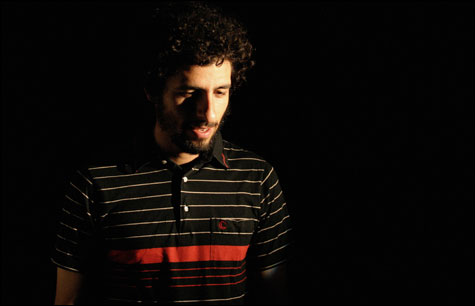
HE CONTINUES TO READ SCIENTIFIC AMERICAN — so maybe that PhD in biochemistry is still a possibility!
|
Late last year, the New Yorker busted short-story writer Raymond Carver. Turns out the leader of the literary minimalist movement wasn’t much of a minimalist at all — it was his editor, Gordon Lish, who cut, snipped, cajoled, and distilled his words into the shivering slices of life. Carver’s posthumous outing is proof that even a supposed master of a spartan style doesn’t always have the strength to pare his creations down to the marrow. But there are also those who find they can’t make art any other way. They would include José González, a Swede of Argentine descent who, as a singer-songwriter, is ruthless in his devotion to aural minimalism. One might assume otherwise to judge by his hushed speaking voice, his sharp cheekbones, his birdlike frame. Yet during the most intense moments of his performances, with his head bent over his nylon-stringed acoustic guitar, it becomes clear that González, who headlines the Paradise next Thursday, possesses the will power and the patience to dig into each of his songs until he has exhumed its bleeding heart.
“I’m always trying not to add more than I need to. I try to make the most of the guitar,” says the 29-year-old over the phone from his home city of Göteborg. It’s just a couple of weeks before he leaves for a North American tour to support his second full-length, In Our Nature (Mute). “I think whenever you start adding more and more instruments to a recording, you’re also losing something. That’s the main reason I want to keep it simple, because I think something is gained through that simplicity.”
González has kept the essence of this vision intact since the release of his debut album, Veneer, in 2003. (The first US version came out in 2005.) It’s represented in everything from the sparse recordings themselves to the pretty pencil drawings by Elias Araya that adorn the CDs.
At 14, he began learning to play the Beatles songs and bossa nova tunes his father had grown up with. But music wasn’t always his priority. He had nearly completed a PhD in biochemistry at the University of Göteborg when Veneer earned him a sudden global reputation. At first, he attempted to continue with his degree — hardly surprising given his ambition. “At the time, I was working my ass off, and also recording the songs for Veneer and doing more and more shows. So I was worried, because the PhD, the research project, was lacking. But as soon as I made a decision, it was pretty clear that I’d made a good choice.” And he doesn’t regret that choice, though he admits that he’s still “a bit of a nerd” and enjoys reading Scientific American while he travels.
González’s science background might be reflected in his desire for control and discipline in his songwriting — the way you’d prepare the hypothesis for a lab experiment and then take great pains to ensure accurate results. “I think it’s sort of typical for me to be very restrictive and conscious of what I’m doing,” he says of his creative process. “I think it’s more about my personality than anything else.”
Veneer’s early popularity was fueled in part by González’s aching cover of “Heartbeats” (originally recorded by Swedish electronica outfit the Knife), which was featured in an ad campaign for a Sony Bravia television. Soon a viral YouTube video of the commercial was circulating. Thousands of small, multi-colored bouncing balls careered in a wild ballet through the streets of San Francisco, with the stripped-down “Heartbeats” as the only soundtrack to their dance. Veneer earned González a string of European awards and, in 2006, a US deal with Mute. Critics championed its bossa-nova-meets-Amerindie æsthetic, and the Nick Drake and Elliott Smith comparisons flowed in. Yet González still thinks of the tunes on Veneer as mere sketches. For In Our Nature, he says, “I wanted to make proper songs.”
Retaining the basic elements of Veneer — an acoustic guitar and his balmy tenor — he added percussion, courtesy of Erik Bodin, and a spare of backing vocals by Yukimi Nagano. There’s even a touch of synthesizer (Håkan Wirenstrand). And he found himself drawing more and more from Brazilian music and beyond, citing João Gilberto as a big inspiration, along with Fela Kuti and Nina Simone. The upbeat drumming and the ivory tickling are charming additions to his songs. But they remain as subtle as a whisper. If Veneer is a melancholy Seattle winter when your seasonal depression forces you to buy a light-therapy lamp, Nature is a too-long South American summer spent weeping over your cruel paramour in a beach shanty.